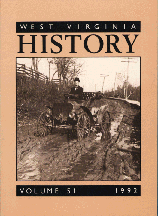

(A copyrighted publication of West Virginia Archives and History)
 |
A Tenuous Trek: A Visual Journey Across The Mountain State Volume 51 (1992), pp. 79-98 |


 |
A Tenuous Trek: A Visual Journey Across The Mountain State Volume 51 (1992), pp. 79-98 |
In 1984, the West Virginia State Archives launched an innovative photograph-copying project to collect and preserve the state's visual heritage. To date, Berkeley, Calhoun, Clay, Fayette, Hardy, Harrison, Lewis, Mineral, Ohio, Pendleton, Pocahontas, Roane, Summers, and Upshur counties have all participated in this project (which is a cooperative effort between a local sponsor and the Archives) and some 7500 photographs have been copied. All known information about the photographs (names, dates, locations) is recorded and credited to the owner. The photo is not harmed in any way by the copying process and is immediately returned to the owner. Contact sheets of the copy negatives are placed with the community sponsor.
Most of the photographs used in this essay have been obtained through this project. All are from the West Virginia State Archives photograph collection, which is an excellent resource for historical research, exhibits, publications, and special features in newspapers or films.
Between 1900 and 1950, travel in West Virginia underwent extensive growth and improvement. The expansion of railroad and river transportation, better roads, and the beginning of flight services all lessened the barriers to travel imposed by the state's mountainous terrain. Over time, improved transportation systems hastened the exportation of resources from West Virginia while encouraging tourism based on the state's rugged natural beauty and diversity.
By 1850, West Virginia had four significant east-west turnpikes. The National Road from Cumberland, Maryland, to Wheeling was completed in 1818. The James River and Kanawha Turnpike opened in 1826, extending from Monroe County to the mouth of the Big Sandy River, and was one of the busiest roads in Virginia until 1852. The Northwestern Turnpike, completed in 1838, connected Winchester and Parkersburg, and the last of the turnpikes, the Staunton to Parkersburg, was completed in 1847. Numerous shorter turnpikes like the Weston and Gauley Bridge ran north to south to connect with these east-west routes. Horse-drawn vehicles of all types furnished personal, business, and industrial transportation well into the early twentieth century.
Railroads in the state developed more slowly. The only major line at the time of the Civil War was the Baltimore and Ohio. In the 1870s, railways were extended into the rich coal- and timber- producing areas and, along with improved river transportation, channeled raw materials from the mountains to the markets. These methods of transport, for both passengers and goods, were gradually replaced by the convenience and speed of motor vehicles and later air travel by the 1950s.
The increasing importance of motor vehicles led to a series of improvements to West Virginia roads between 1917 and 1954. The 1917 Good Roads Amendment designated 4,600 miles of country roads to be included in a state road system funded through Federal Highway Act money and state bonds and tax revenues. In 1933, 31,166 miles of road were added to this system with the creation of the State Road Commission. The completion of the West Virginia Turnpike in 1954, connecting Charleston and Princeton, followed by the development of the modern interstate and Appalachian Corridor systems, were tremendous assets in the state's developing tourist economy.